by Prof.
David N. Nikogosyan, University College Cork, Cork, Ireland
(click on photos to enlarge image)
AN UNKNOWN MARK FOR SILVER-PLATED HOLLOW WARE
USED BY CHRISTOFLE IN 1930-1935
The famous French silversmith company Christofle is one of
the world pioneers in the mass production of inexpensive high-quality
silver-plated items, which started 170 years ago and continues
to the present day. This paper contains a brief overview of Christofle
marks for silver-plating and in addition presents a newly discovered
one.
Figures 1 a and 1 b demonstrate the first Christofle standard
full mark, used from 1844 to 1862
(Literature: 1). The main components of this mark are: 1)
The oval mark with four stars, two capital "C" letters which
mean Charles Christofle, between them a balance and a bee image
in the center above two palm-like branches. We will call such a
mark the "CC" oval mark; 2) The inscription Christofle in a
cartouche; 3) The item number running from 1 to at least 290011
(the number which I have in my collection). It follows that the
mean productivity of Christofle hollow ware silver-plated items
in the mentioned time period was at least 16000 items per year;
and 4) The silver content numbers in lozenge-shaped boxes. The
size of the "CC" oval mark is between 2.1 x 3.4 mm and 2.4 x 3.7 mm.
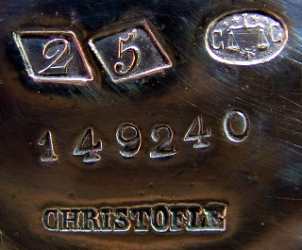 |
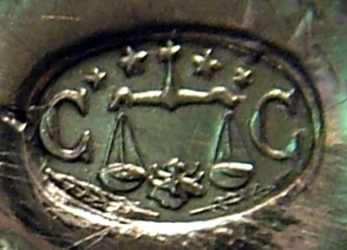 |
Fig.1 a: The first
standard Christofle
mark, used in 1844-1862
|
Fig.1 b: The "CC" oval mark
|
Figures 2 a, 2 b, and 2 c demonstrate
the second standard full mark of Christofle, used on
silver-plated hollow ware in 1862-1935
(Literature: 1, 2 and 3). Let us compare this mark with the
earlier one, depicted in Fig. 1a. The main difference is that in
the later case the "CC" oval mark is put inside a the square box.
We will call such mark the "CC" oval/square mark. According to the
information obtained from Kathryn Vaughn
(Literature: 4), the mark in the square box is called the
poinçon de responsabilité and refers to one of three
legislated marks on French silver plate. Its use on silver
plated goods in France was decreed on 26 May 1860 to consist of
the maker’s initials and symbol in a square box. A bee image between the
balance plates is absent; instead there is an image of a flower
(rosette). Another new
element is the designation of the silver content (so-called
marque de grammage) in square boxes instead of the
former lozenge-shaped ones. Finally, the presence of a new specific element, the
rhomb with the inscription "METAL BLANC", should be added.
We will call it the "mb" rhomb mark. This mark appeared
sometime after 1878 and was used for marking the Maillechort
(Alpacca) base metal (Fig. 2 b). There was no marking for other
base metals used for silver plating (Fig. 2 a), but the use of
these other base metals was continued after the introduction of
the rhomb mark, though in smaller quantities. My calculations
show that around 40% of the silver-plated Christofle items,
issued in 1878-1935, do not carry the "mb" rhomb mark.
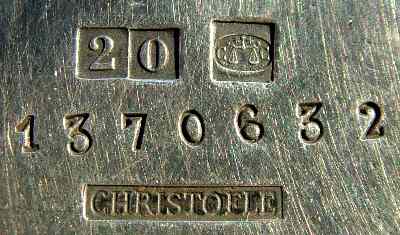 |
Fig. 2 a: Standard full mark used in
1862-1935
|
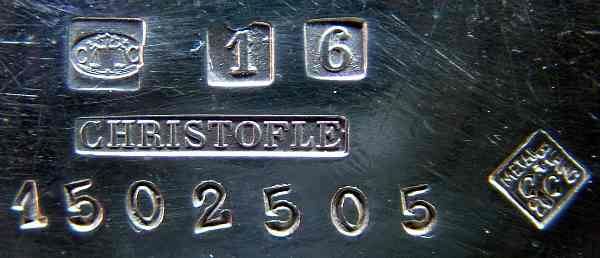 |
Fig. 2 b: Standard full mark used in
1862-1935 (with a rhomb sign for Maillechort base
metal)
|
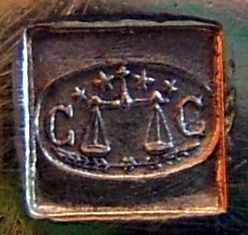 |
Fig. 2 c: The "CC" oval/square mark
|
The third legislated mark inside the full
standard mark used in 1862-1935 is the so-called
marque de fabricant
(Literature: 4) or simply the foundry name. In
our case it is the "CHRISTOFLE" inscription in a
cartouche. The length of the "CHRISTOFLE" inscription
inside the full standard mark is not standardized and
varies for different items from 5.2 to 10.4 mm. The
most frequently found length (in every second item!)
is 7.6 + 0.2 mm. Contrary to that, the ratio
of the length of "CHRISTOFLE" inscription to its
height is very stable. Throughout the XIX century,
the mean ratio for 30 pieces is 8.8 + 0.2,
while for 19 pieces made in the XX century it is
equal to 9.1 + 0.2.
Now let us consider the items' numbering. In my
collection there are 44 Christofle items issued in
1862-1935 with numbers starting from 359 and
finishing at 2933420. Sometimes, the numbering is
placed separately from other marks. Sometimes, the
pieces with "CC" oval/square mark possess no
numbering; amongst them the pieces made after 1930.
My next task was to correlate the numbering with the
time, in other words, to date the numbers. First
this problem seemed to be an intractable one, but in
2006 I was lucky to purchase a dated milk can,
bearing the number 1776073 and signed Salzburg 98
(Fig. 3). I supposed that this milk can with a
number 1.77 million (1.77 M) was made in 1898 or a
little bit earlier. Another reliable time point
should be the year 1862, starting from which the
Christofle items with the "CC" oval/square mark were
produced. Taking this into account, we can easily
calculate that the mean productivity of Christofle
silver-plated hollow ware (including trays) during
these thirty-six years (1862-1898) was equal to about
50,000 pieces per year.
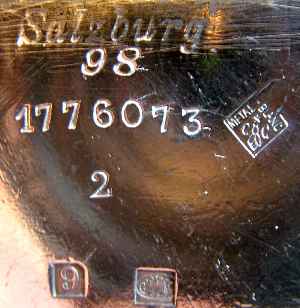 |
Fig. 3: A Christofle mark with additional
inscription "Salzburg 98"
|
In 1935, the third standard full mark
was introduced (Figs. 4 a), which was in use until 1983
(Literature: 1, 5). Instead of the initials "CC" it contains the initials
"OC" which means "Orfèvrerie Christofle" (Silversmith Christofle).
It should be noted that contrary to the "CC" oval/square mark, the
"OC" mark is enclosed in a lined rectangular box. We will call this
mark "OC" oval/rectangular mark. Another difference lies in the
drawing inside the oval. While the standard "OC" oval/rectangular
mark contains a bee (Fig. 4 b), the above-mentioned "CC" oval/square
mark contains some kind of flower (rosette) instead of a bee
(Fig. 2 c). The size of the oval is about 1.6 mm x 2.6 mm (for
four items at my disposal), which more or less corresponds to
the size of the oval in the "CC" mark (see above). The ratio for
the "CHRISTOFLE" inscription is 8.6 (mean value for five items)
and again corresponds to the ratio value in the case of "CC"
mark. The full mark, used in 1935-1983, includes another unique
element to indicate the silver-plating
(Literature: 6), namely, a "knight" chess figure between two
letters "O" and "C" in a square box (Fig. 4 c). The size of the
box varies between 1.8 mm x 1.8 mm and 2.2 mm x 2.2 mm.
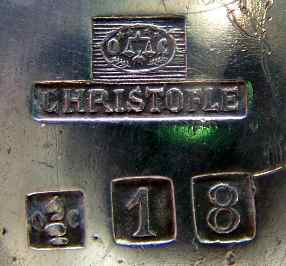 |
Fig. 4 a: Standard full mark used between
1935 and 1983 (without numbering)
|
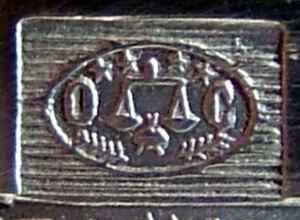 |
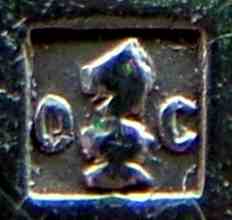 |
Fig. 4 b: The "OC" oval/rectangular mark
|
Fig. 4 c: The silver-plating designation,
used in 1935-1983
|
After this long introduction, I would like to present a recently
found Christofle mark for silver-plated hollow ware, which to
the best of my knowledge has not been reported before. This new
"intermediate" standard mark is shown in Figures 5 a and 5 b. It
has common features with both the "CC" oval/square and the "OC"
oval/rectangular marks. Similar to the "CC" oval/square mark
(Fig. 2 c), it possesses the "CC" inscription that proves the
use of this mark before 1935. In the new mark, the oval
inside the square is given separately from the foundry name,
similar to the "CC" oval/square mark. However, the oval of
"intermediate" mark is placed in a lined box and contains a bee
instead of a rosette, like the "OC" oval/rectangular mark (Fig.
4 c). The size of the oval is about 1.6 mm x 2.5 mm (for two
items at my disposal), which more or less corresponds to the
size of the oval in the "CC" oval/square mark (Fig. 2 c).
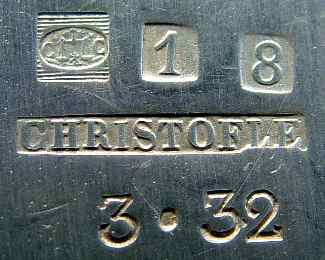 |
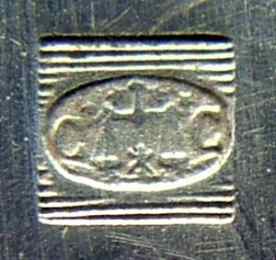 |
Fig. 5 a: Image of the "intermediate"
standard
Christofle mark, used between 1930 and 1935.
The numbers 3•32 could simply refer to the month
and the year of production, which means March 1932
|
Fig. 5 b: The "CC" oval/square mark used
inside the "intermediate" Christofle mark
|
Finally, I also discovered the "intermediate" oval mark on the
Christofle silver-plated item, made of Gallia base metal (so-called "ORFÈVRERIE GALLIA")
and issued at the same time (Fig. 6). However, the oval size of the corresponding mark used on Gallia items is
significantly smaller, only 1.1 mm x 1.6 mm.
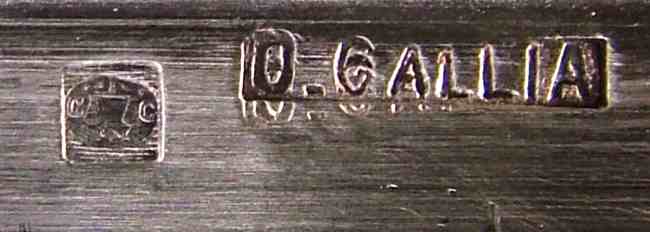 |
Fig. 6: The "intermediate" "CC" oval/square
mark on the Christofle silver-plated
item, made of Gallia base metal
|
The author is grateful to his wife
Danielle for her continuous support
LITERATURE
1. Marc de Ferrière, Christofle: 150 ans d’Art et de Rève.
Dossier de l’Art, No.2, pp.3-73 (1991)
2. Christofle. Orfèvrerie Argentée, 1862-1883. (Reprint produced
by Collection Livres, Bruxelles, 2004)
3. Christofle & Cie. Orfèvres Usines à Paris et à Saint-Denis. (Siège
Social et Manufacture, 56, rue de Bondy, Paris, 1922)
4. Kathryn Vaughn, private communication
5. Christofle: Marks & History,
http://www.925-1000.com/a_christofle.html
6. Dedo von Kerssenbrock-Krosigk and Claudia Kanowski,
Modern Art of Metallwork. (Bröhan-Museum, Berlin, 2001), pp.
386-393
David Nikogosyan can be contacted at niko@phys.ucc.ie
Prof. David N. Nikogosyan,
University College Cork, Cork, Ireland
- 2010 -
|
|
|
 ASSOCIATION OF SMALL COLLECTORS OF ANTIQUE SILVER
ASSOCIATION OF SMALL COLLECTORS OF ANTIQUE SILVER










